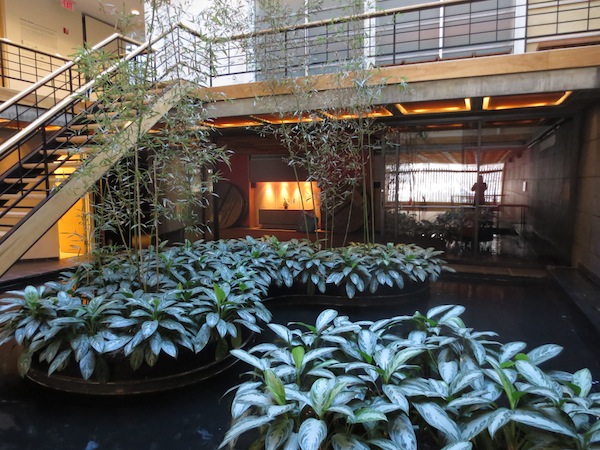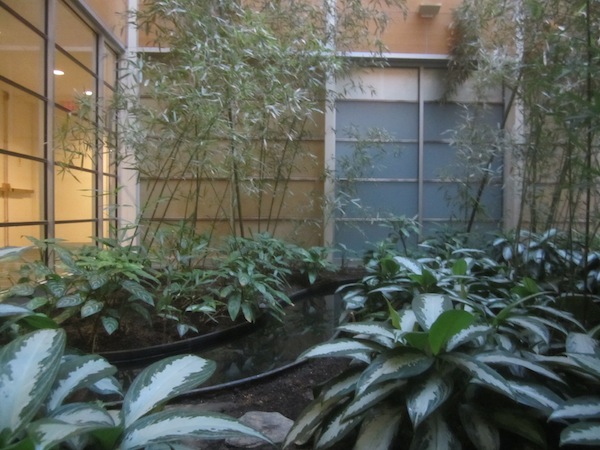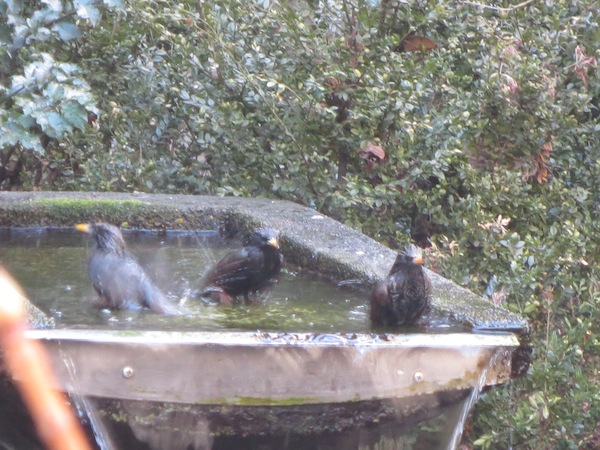Winter Garden Escapes in New York City Part Two: Rainforests, Waterless Falls and a Newly Discovered Pocket Park on the Way Home.
After a visit to the Birch and Fern Forest in the New York Times Building, my quest for winter garden escapes in Manhattan next took me to the Ford Foundation Building and the Japan Society.
My first stop was the Atrium of the Ford Foundation headquarters, located at 320 East 43rd Street. Completed in 1968, the glass, tree-filled space was revolutionary for its time and is credited with helping to change the way public spaces were treated in office buildings. The garden occupies an area on the ground floor of the building between 43rd and 42nd streets, and is terraced to compensate for the natural sloping topography of the lot.

This allows the visitor to walk up and down a number of paths and steps connecting the different levels, experiencing the garden from different perspectives. The lush plants in a multiplicity of green hues, from dull to bordering on lurid, transport one far from the winter climate of the Northeastern United States. A square pool with a fountain anchors the center of the space.
Above the tree canopy, a number offices and meeting rooms’ glass walls looked onto the forest from different angles.
In contrast to the New York Times building, the garden appears to interact with the contrasting architectural elements within the larger structure and acts less as a backdrop. The only disquieting element was, except for one gardener working so silently I believe he had a muffler on his trowel, there was not one other person in the space beside myself. I decided to take advantage of the surprising solitude (other than said gardener) and relax for a few minutes by the fountain. It was then I noticed there wasn’t anyplace to sit. I walked around, up and down steps looking for a welcoming spot to sit, my feet increasingly tired from all this walking up and down. The best the garden offered was the edge low brick wall running along one edge of a planter on the outer perimeter of the top level of the space.

Not particularly inviting or comfortable looking. I wondered if there had been benches there at one time and encouraged too many people from surrounding neighborhood buildings to invade the space for their lunch and coffee breaks, or if too many homeless people had fallen asleep on them, or if too many tourists had lingered too long on them, necessitating their removal. Despite the fact that it doesn’t encourage a prolonged stay, it is definitely worth a look. The Atrium is open to public from 8am-4pm whenever the Ford Foundation’s offices are open.
My next visit was to the Japan Society, a few blocks north of the Ford Foundation, at 333 East 47th street. Actually, I visited it twice. The entrance to the handsome building housing the Society is discrete, and I almost walked right past it. The garden inside is on two levels. The lower one features a square pool of water containing several islet beds of tropical plants and bamboo.

An open staircase ascends over the water to the upper level. The same three elements, water, tropical plants and bamboo are also employed in the upper part, but to a different effect. The plant-filled beds dominate this area, and the area devoted to water contracts, becoming a lazy stream winding through the plants, flowing over the open edge and down a rock wall into the pool below.


At least it does in theory. The first day I came there was no water flowing down the wall.
One must pass by the admission desk to the galleries to get to the garden space beyond. I asked the young woman behind it if the waterfall was usually on. She said yes, but seemed unsure. I asked if the general public could access the garden, and she again seemed hesitant, saying yes, but told me to be sure to let anyone on the upper level who asked that I was just looking at the garden (one must pay admission to view the galleries, which are on the other side of the garden). The design was appealing, a mix of modern and traditional elements with a dynamic interplay between organic and architectural materials. I stopped by again a few weeks later, hoping to catch the waterfall in action. Again the waters were still. This time, the reason given was that the galleries upstairs were closed while they were in the process of changing exhibitions. I told a different young woman at the desk that I was writing a piece on indoor gardens in New York and if it was ok to take some pictures of the upper level from the stairs. She politely and hesitantly replied no. Since I had some pictures from my first visit I didn’t push the issue. She helpfully offered to take my information and have the Society’s Public Relations person email me some information and photos, which I found very kind (although none ever came). I was disappointed though, as this gem of a garden is hardly a place one can immerse themselves in, let alone linger, serving more as a transient experience for those going to view the collections or attend activities at the Society.
I left, going back out into the sunny but briskly cold January day, and began walking westward towards the Lexington Avenue Subway line. A few doors down, the surprising site of a pocket park street stopped me. Part of the churchyard for the Church of the Holy Family at 315 East 47th St., the wide-open gate and comfortable looking benches beckoned.

Although the temperatures had been firmly stuck in the 20’s for the past several days, the sunny spot, sheltered on three sides by the surrounding buildings, felt distinctly warmer. The water in the garden’s two pools, fed by a small stone fountain and crossed by a charming arched stone bridge, remained unfrozen.


A modern statue of the Virgin Mary (although that might be a little presumptuous, it could well and been the Magdalene Mary, or any other female biblical character of a certain age, save Eve, I suppose) in the back of the garden was the only overtly religious reference I noticed. I sat on one of the benches, admiring the colors and textures of the mix of evergreen and deciduous plants. This was every thing a mini garden escape should be – accessible, welcoming, and tranquil without seeming desolate. Although no other humans joined me, during the five minutes I sat there, a countless number of birds flew down and hopped into the fountain, splashing and drinking, having just as good a time as I was.



